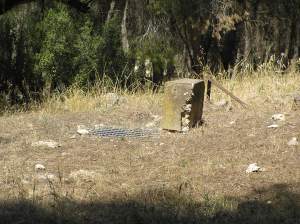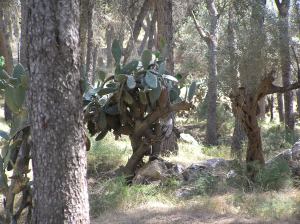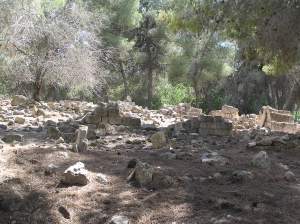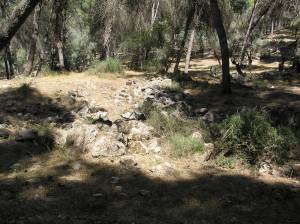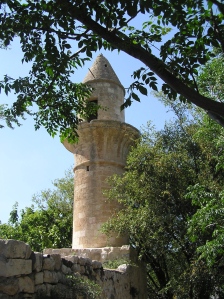Tags
Today we met up with Jonathan Cook who is a journalist, formerly for the Guardian but now freelance, who has lived in Nazareth in 2001. He is also the author of several books on the Palestine / Israel situation. 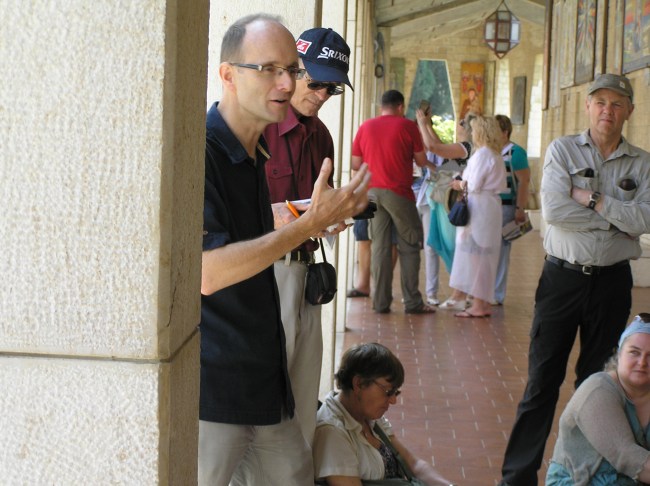 The following is based on my notes taken as Jonathan was speaking to us and subsequent reading:
The following is based on my notes taken as Jonathan was speaking to us and subsequent reading:
Jonathan began by explaining that Nazareth is a Palestinian city – the only one in Israel since 1948. The population of Nazareth includes 60% refugees from the 1948 war. They are termed “present absentees” because they have been displaced from their homes, many of which were subsequently destroyed, but are living in Israel. “Absent refugees” are those refugees who now live outside of Israel. They do not have official refugee status.
Israel’s long term strategy after 1948 was a process of Judaisation whereby the the Palestinian population would eventually be “transferred” to be replaced by a Jewish one. The term Judaisation is not considered to be politically acceptable today however so the word “development” is used instead. The process started with ethnic cleansing under cover of the 1948 war of independance – the expelling by force of the populations of 500 Palestinian villages. The villagers were compelled to flee and most ended up in refugee camps in Palestine (like the ones in Bethlehem and Jenin) or in Jordan, Syria or Lebanon.
In Israel there are 124 recognised Palestinian communities. Nazareth is the only city (effectively the Palestinian capital in Israel). There are also about 80 unrecognised Palestinian villages, mainly in the Negev which includes Bedouin villages . Villages that are not recognised are counted as illegal by the Israeli government and receive demolition orders which mean that they can be (and are) demolished at any time.
Jonathan has Israeli citizenship which took 8 years to obtain. However there are two citizenship laws which are based on ethnicity. Jews have automatic citizenship through the “law of return” 1950. A separate law applies to non-Jews (1982?).
Since 2003 Palestinians must have a permit to enter Israel. Palestinians in Nazareth often have family in the West Bank, but the law effectively prevents them living together even if married. Israeli citizenship is not the same as being an Israeli national – there is no Israeli nationality as Israel is a Jewish state, not an Israeli state. This results in discrimination based on ethnicity. Israeli Jews have rights that no one else (least of all Palestinians) are allowed. The Issuing of identity cards allows discrimination to take place by identifying people by their ethnicity, often in subtle ways such as by writing the date of birth in a different language (e.g. Hebrew for Jews, Arabic for Palestinians).
There are 57 laws in Israel which discriminate on ethnicity or religious grounds. Although civic rights are roughly the same for all citizens, there are also “national” rights which only apply to Jews. Eg. Jewish people can lease a house from the state for 99 years – this right is not available to non-Jews. In disputes taken to court, national rights are always upheld over civic rights.
How do you prove that you are a Jew? The law of return says you must have at least one Jewish grandparent.
There is no civil marriage in Israel. Marriage can only take place within a religion. This causes problems. If a Jew wishes to marry a Muslim or a Christian, one of them must convert – the only other way is to marry abroad. The Rabbis decide who are Jews and who are not – Judaism is passed through the female line.
In 1948 the question for the Jewish army arose as to whether to expel the Arabs from Nazareth. David Ben Gurion said to the generals that “The world is watching” because he knew that Nazareth was important to the church. This effectively saved Nazareth because Ben Gurion was concerned that expelling the population would not go down well internationally and might prevent the UN from recognising the state of Israel.
For several hundred years there has been a Christian majority in Nazareth. In 1948 many fled to Arab states and many refugees moved in, mostly Muslim. The population is now 1/3 Christian and 2/3 Muslim but most civic amenities are run by Christians and they constitute the middle class.
We travelled a short distance out of Nazareth to Nazareth Ellit – a Jewish settlement built on the hill overlooking and dominating Nazareth. Entrance was past a very large Israeli flag which conveys a very clear message. The existence of Nazareth Ellit serves to fragment Palestinian communities – it prevents the natural expansion of the city to encompass smaller outlying villages. It also pulls resources from Nazareth – Eg. buildings such as the army base are “annexed” to Nazareth Ellit so that all taxes go to Nazareth Ellit rather than Nazareth. Its situation on the top of the hill overlooking and dominating the skyline of Nazareth means that it provides a psychological message of dominance and is also well placed for surveillance and monitoring of the old city.
From here we travelled out of the city to visit the site of the demolished village of Lubya. This is within a forested area designated as a National Park. The remains of the village, one of the ones evacuated in 1948 were clear to see. Destroying the villages and planting forests over them is a way both to ensure that the Palestinians who lived there cannot return and also to prevent awkward questions from tourists seeing the remains. There was a muslim graveyard amongst the trees – sad to think that people had been forced to leave behind the graves of their loved ones.
We visited another site near Tiberius where another village had been destroyed but the remains of a Mosque had been spared. This is an ancient Mosque built by Saladin after had defeated the crusaders – it should be a world heritage site but is currently a “closed military zone” with a road being built nearby. I hope they don’t have any accidents with the bulldozers!
We continued on to the site of a further destroyed village of Saffuriyya – the site of which is now the Jewish village of Moshav Tsipori. We then returned to Nazareth to visit a museum which has been set up to remember the destroyed villages. The owner has spent many years building up a collection of artefacts from the villages.

